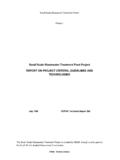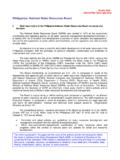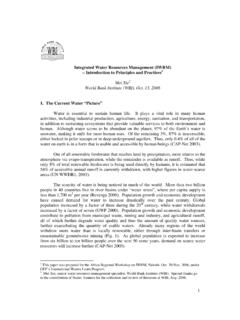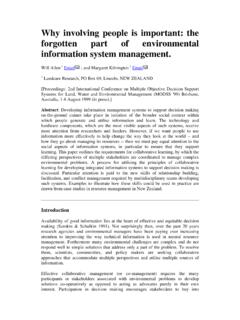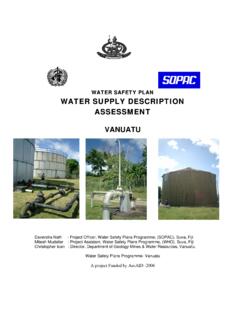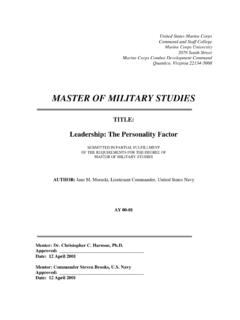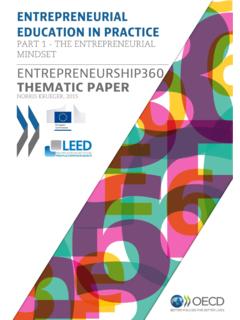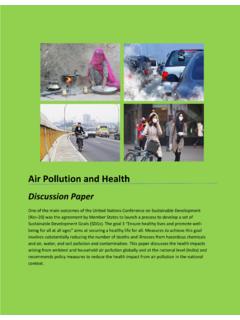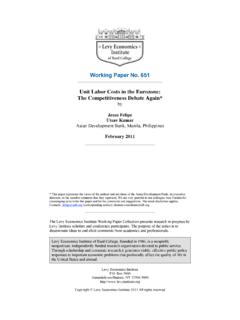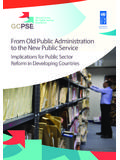Transcription of The Hydrogen Sulphide (H2S) Paper-Strip Test
1 The Hydrogen Sulphide (H2S) Paper-Strip Test A simple test for monitoring drinking water quality in the Pacific Islands Luke M. Mosley1 and Donald S. Sharp2,* 1 South Pacific Applied Geoscience Commisssion (SOPAC) 2 World Health Organization* (WHO), Suva, Fiji Islands SOPAC Technical Publication 373 March 2004 *Disclaimer: This document reflects the views of the authors and not necessarily those of WHO Introduction Many people living in the Pacific Island region are reliant on drinking water from shallow ground water lenses and streams, or from roof catchment systems. These water resources are often scarce and vulnerable to contamination from poorly installed sanitation facilities (Falkland 1999).
2 The majority of the Pacific s population therefore is at risk to waterborne diseases (Pr ss et al., 2002). Many islands are too small in size and under resourced to support conventional water treatment facilities and distribution networks. In urban areas, distribution and treatment systems are reasonably common although maintaining the systems in good working order is sometimes difficult. People living in rural areas and outer island groups are most at risk of contracting waterborne diseases, as they do not typically have access to treated water. Microbiological and chemical testing of drinking water quality should be performed to indicate whether water is safe to drink.
3 Unfortunately, in many Pacific Islands the infrastructure needed to adequately monitor water quality is either non-existent or inadequate. A lack of monitoring is particularly apparent for outer islands and rural areas. Typically, the key water quality parameter that indicates safety is is the absence faecal coliform bacteria in the sample. These bacteria indicate the probability of pathogens ( typhoid and cholera) being present. Sophisticated and costly equipment is required to test for these organisms; an incubator, filtration apparatus, and chemical reagents, which must be stored under refrigeration. The cost of one test can be more than NZ$30, depending upon the type of test and method used.
4 In addition, samples for coliform analyses must be kept chilled and delivered to the laboratory within 6 h. in order to adequate preserve the sample. In all cases, the time elapsed between collection and examination should not exceed 24 h (APHA, 1995). Although there are several commercially available portable kits that make it possible to carry out on-site water quality testing, these are usually costly and require technical expertise to operate (Bartram & Balance 1996). An alternative low-cost test for faecal contamination in drinking water which is simple to use and easy to interpret is the Hydrogen Sulphide (H2S) Paper-Strip test (Manja et al.)
5 1982). Aim of this Report The aim of this report is to provide information on the scientific basis, manufacture and use of the H2S paper strip test in the Pacific Islands. Suggestions are given on how the test could be utilised for rural, outer island and community-based water quality monitoring. Indicators of faecal pollution Untreated or improperly treated drinking water may contain microorganisms of faecal origin that are pathogenic (disease causing) such as those that cause cholera and typhoid fever. The presence of pathogens in drinking water is usually due to human and animal waste entering the water source. The sanitation facilities that are used predominantly in rural/outer islands of the Pacific are septic tanks and pit latrines, which do not provide sufficient treatment to remove pathogens.
6 The waste outflow from these types of facilities, in certain soil conditions can travel several hundred metres underground (Dillion 1997). Animals ( pigs and cows) in the area of an unprotected water supplies can also cause serious contamination and pose risks to public health. It is difficult and expensive to test for the pathogenic organisms that may be present in contaminated drinking water. Therefore indicator organisms are used to determine the risk that these organisms might be present in drinking water. Indicator organisms are always present in high numbers in faecal material, whether or not pathogenic organisms may be present.
7 A high level of indicator organisms in a water sample indicates a high risk that pathogenic organisms might also be present. The most common indicator organisms used to determine bacteriological water quality are total and faecal coliforms. The coliform group of bacteria, along with many other naturally occurring bacteria, inhabit the intestinal tract of warm-blooded animals, including humans, and are discharged in their faeces. Faecal coliform presence indicates that water is contaminated with faecal matter and is not safe for drinking purposes. In the tropics, coliforms are not an ideal indicator as they can occur naturally and reproduce in soil and water at the ambient temperatures (WHO 1996).
8 Other indicator organisms are sometimes used which are in the Enterococcus bacteria group such as faecal streptococci (WHO, 1996), and Clostridium perfringens. The problems noted above with the sophisticated testing procedures and equipment required for the analysis of the above indicator organisms make their use difficult in rural areas and on outer islands. Another less commonly used indicator is Sulphide -reducing bacteria and the following sections outline the use of a low cost test for these bacteria in drinking water called the Hydrogen Sulphide (H2S) Paper-Strip test. There are many advantages of this test for use in rural and remote Pacific Island communities particularly where conventional monitoring is not possible or too expensive.
9 Background and scientific basis of the H2S test In 1975, Allen and Geldreich showed that the presence of coliforms in water was also associated with Hydrogen Sulphide (H2S) producing organisms. In 1982, Manja et al. developed a simple Paper-Strip method to screen for bacteriological contamination of potable waters. This study and several subsequent studies, have found that the H2S test gave generally good agreement with the standard Most Probable Number (MPN) and membrane filtration methods commonly used for determining the presence and number of coliform and faecal coliform organisms (Hazbun & Parker 1983; Dutka 1990; Castillo et al.)
10 1994; Martins et al. 1997; WHO 2002). As noted in a multi-country intercomparison study summarised by Dutka (1990), this test is an ideal tool for testing rural and isolated drinking water supplies . Bacteria can produce Hydrogen Sulphide through the anaerobic catabolism of cysteine, an amino acid containing the sulfahydryl group, or by the use of elemental sulphur or some oxidised sulphur compounds as the terminal electron acceptor in their metabolic processes. All members of the Enterobacteriacae group are capable of the former while the latter occurs in dissimilatory sulphate-reducing bacteria. The H2S test uses a medium with thiosulphate as a sulphur source and ferric ammonium citrate as an indicator, only certain enteric bacteria will produce Hydrogen Sulphide resulting in the development of a black precipitate.
